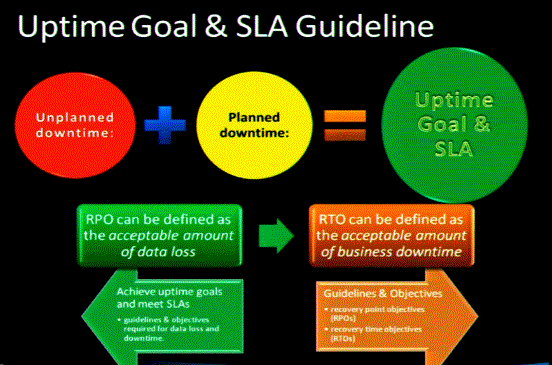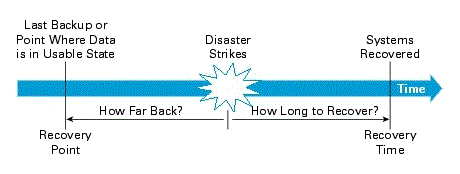Table of Contents
What is RPO (Recovery Point Objective) ?
Recovery Point Objective(RPO) describes a point in time that data can be restored from. For instance, if there is data corruption, Data loss or unavailability, at what point in time can a valid copy of the data be restored from? RPO is usually measured as minutes, hours, days, weeks, etc… for Business Continuity.
If a database is corrupted then can we restore it back to what it was 15 minutes ago? This would be an RPO of 15 minutes for Business Continuity.
What is RTO (Recovery Time Objective) ?
Recovery Time Objective (RTO) is the amount of time which data or hardware is desired to be restored after a data corruption or hardware failure. RTO is also usually measured as minutes, hours, days, weeks, etc… for Business Continuity.
Disaster Recovery RTO RPO or Business Continuity RTO RPO is very important for a Business Recovery time needed to recover if a disaster seemed to happen. Time needed for Business data recovery is RTO. This can be minutes to hours depending on where the DR Site is located and backups are located.
If a Database server just died then comes into play is database rto rpo. Time needed to bring it up and running again? If the answer is one hour then the Recovery Time Objective is one hour.
For more information please read my post here.
Some of the methods to make sure Disaster Recovery RTO and RPO is covered fully are SQL Server Full backup, Differential backup, SQL Server Transaction log backups, physical server backup, server backup using any other backup application and cloud virtual server backup etc. Only way to make Business Continuity RTO RPO are covered is to do test Restores from time to time for database rto rpo.
RTO and RPO in SQL Server
For modern businesses, database rto rpo that must meet their customers’ requirements and expectations, downtime is not an option. Various types of catastrophes might occur, affecting your company’s revenue or even its existence that is where the RTO and RPO in SQL Server that is database rto rpo comes of importance. Whether it’s a ransomware assault, a power outage, a flood, or simply human error, these events are unpredictably unpredictable, and the best you can do is “BE PREPARED” by properly managing the RPO and RTO in SQL Server Databases for time and point of recovery that is database rto rpo.
Preparedness entails having a good business continuity and Disaster recovery plan (BCDR plan) in place with the SLA’s defined for RTO and RPO in SQL Server. RTO and RPO in SQL Server has to be the one that has been well tested and can be readily implemented.
BCDR plan (Business Continuity and Disaster recovery plan)
The Recovery Point Objective (RPO) and Recovery Time Objective (RTO) are two critical factors that constitute a BCDR plan (RTO). Let me give you a quick rundown in short words of these phrases for those of you who are unfamiliar with respect to SQL Server:
- RPO SQL Server sets a limit on how far you can go back in time and establishes the maximum amount of data that can be lost in the time between a failure and the last good backup.
- RTO SQL Server is a term that refers to downtime and describes how long it takes to recover from an issue until users can resume normal operations.
Real Time RTO and RPO Examples
You can construct your business continuity plan using a 3 tier paradigm, for example:
Tier 1: Applications that require a response time of fewer than 10-15 minutes.
Tier 2: Business-critical applications with a 1-2 hours SLA maximum in RTO SQL Server based applications and a 2-4 hour maximum in RPO SQL Server based applications.
Tier 3: Non-critical applications with an 4-5 hours SLA maximum RTO SQL Server based applications and an RPO SQL Server based applications of 24-36 hours.


very clear and easily understod.
thank you